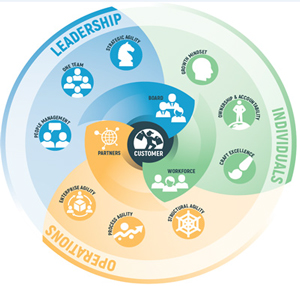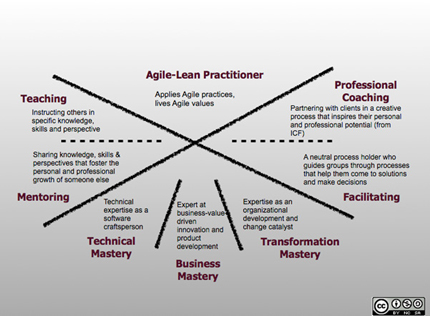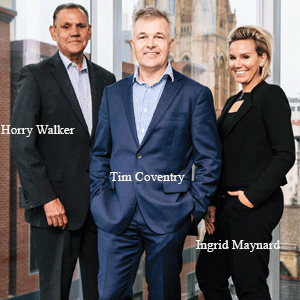THANK YOU FOR SUBSCRIBING

Why Agile Coaching Is Needed For Digital Transformation
Shane Hastie, Director of Community Development, ICAGILE


Shane Hastie, Director of Community Development, ICAGILE
Digital transformation is the latest wave of organizational changesweeping businesses around the world. Every business realizes that to be competitive and relevant in today’s complex and volatile marketplace, they need to be ‘digital to the core. ’But how many realize what is actually involved and the depth of change that is needed to truly become a digital business?
When we talk about becoming an agile digital business, we really mean building on the good ideas that have been around for a long time about putting customers first; changing our focus from the purpose of the business being shareholder return to what Peter Drucker told us in 1954, “the purpose of a business is to create a customer.” In the digital era, empowered people use the technologies available to create and delight our customers.
It starts with empowered and energized people adopting and embracing the technologies of 21stcentury business (web, mobile, bigdata, machine learning, artificial intelligence) and shifting the organizational centre of gravity away from the interests of shareholders and executives toward delighting our customers and engaging our people. There is ample evidence that when organizations make that shift, profitability and sustainability follow.

The Business Agility Institute provides a view of the do mains of business agility that identifies the areas where organizations need to change in order to unleash the benefits that are possible from digital transformation. This really means changing every area of the business in ways that are truly disruptive to the current structures, relationships, competencies, and activities.
Organizational change to this depth and extent is hard and for most people because it means completely new ways of thinking and working. The changes needed are truly transformational, impacting the very DNA of the organization, the structures, reporting-lines, relationships, value streams, and interactions. It demands that people shift to entirely new ways of thinking and acting. Transformational change is all-encompassing and irreversible. Like the often-cited metaphor of the caterpillar morphing into a butterfly, stopping part way along the journey is likely to kill the organism.
Making the attitudinal and mindset shift is not something that happens just from attending a training class and adopting a framework of new practices. People need support and guidance as they adopt new ways of thinking and working and build new habits.
Enter the agile coach!
Agile coaching is a craft intended to guide others in understanding, processing, and embracing constant change, so that the change is sustainable, lasting beyond the individuals. Agile coaches guide individuals and teams to get clear about the change they desire, identify places where current reality does not match desired reality, and then take action to close the gap—all in service of delivering business results that matter. Along the way, coaches hold the bigger view of desired change, even when others may have lost sight. Agile coaches support, guide, coach, teach, mentor and facilitate change without colluding with the current reality.
The discipline of Agile Coaching emerged in the mid- 2000s following the imperative to adopt new ways of working in information technology. As the complexity and depth of this imperative became clear, agile approaches needed to be adopted — and quickly — in other organizational areas well beyond IT.
Coaching Competencies
Coaching in this context requires people with a range of competencies. Lyssa Adkins, in her book ‘Coaching Agile Teams,’ presents a model of coaching skills that covers six broad areas.
In order to be effective in the role, a coach needs to be deeply empathic as well as highly skilled and experienced. They need to care more about the outcomes for others than for their own ego and they need to have a true servant leadership perspective. Becoming an effective coach is not something that happens in a short time. Coaches need years (not necessarily decades) of deliberate practice in the various competencies to build the depth of experience and knowledge needed to support others in their transformation journey.
Agile-Lean Practitioner: The coach needs to understand the values and principles that underlie and provide the motivation for the new ways of working. This goes beyond learning the mechanics of a single agile approach, they need to have worked in teams using multiple approaches and understand how the values and principles of the agile manifesto show up in the different practices. They need to be comfortable talking about the details and intent behind frameworks such as Scrum, lean software development, design thinking, lean startup, Kanban, extreme programming, DevOps, and many others.
A coach needs to be able to show how a practice they are proposing to a team or organization aligns with the intent and goals of the transformation and be comfortable to adapt the practice to the context of the team they are working with.
Teaching: A coach needs to have a solid understanding of how adults learn, be able to convey information clearly, and guide others in adopting new tools and techniques. They need to be familiar with concepts such as ‘Training from the Back of the Room’ and be able to present both formal and informal teaching sessions as needed.
Facilitating: As a facilitator, they hold the space for others while making things easy. The coach will frequently facilitate collaborative sessions where groups of people are working together to achieve an outcome. They need to remain neutral, guiding the process using collaboration tools and techniques, and adapting to the needs of the group. When taking a facilitation stance, the coach steps away from their own opinions and allows the wisdom of the crowd to emerge through the design of the session and creating a safe environment for healthy discussion, disagreement, and debate.

Mentoring: A mentor is the “guide on the side”, someone who has more experience and knowledge in a domain than the mentee and freely shares that experience to help the mentee grow in their professional development. When taking a mentor stance, the coach offers up their own experience as examples of “when I did this, here is what I saw”. A key aspect of mentoring is that the mentee has free choice to accept or reject the mentor’s advice.
Professional Coaching: When taking a professional coaching stance, the agile coach starts from the perspective that the individual/team they are working with is naturally creative, resourceful, and whole. Professional coaching is about holding a space for the cache to uncover the solutions they already have to the problems they face and the coach’s role is to use deep listening and powerful questions to help them expose and explore the options available to them.
Technical, Business, and Transformation Mastery: The coach needs to bring to the table deep competency and experience in at least one of these areas. To support a transformation all three areas of mastery are needed, which is one of the reasons only having a single coach is generally not a good idea.As with sports teams, each coach brings a specific area of focus to the organization and it is through the collaborative guidance of a coaching team that all aspects of the transformation are supported effectively.
Coaching is NOT Consulting
A common mistake made by coaches and accepted by organizations is to allow the coach to dictate the approach the organization needs to take for transformation. Any time you make a decision on behalf of someone else, you disempower them and they lose interest and ownership in the outcome. A coach is there to provide options based on their own experience and knowledge of the wide variety of contexts they have worked in, but the decision about which approach to take, framework to use, practices to adopt and, organizations and team structures to start with should be made by the people who are closest to the business needs.
The coach who tells you to adopt a specific model (Spotify, SAFe, Scrum, DevOps,or Racoon) is doing you a disservice. The coach should be explaining the options, the benefits, and pitfalls of a variety of choices and leaving the decision in the hands of the people doing the work. Sometimes they will make mistakes, will need to revisit their decision, inspect and adapt, and that is okay. The coach needs to create a safe environment in which the empowered teams feel confident to make decisions based on their understanding of the work context.
In the book ‘Accelerate’ by Nicole Forsgren, Jez Humble, and Gene Kim, which explores what the most effective organizations are achieving in their digital transformation, they say: “We find that teams which have the authority to experiment with new ideas do better in terms of both software delivery and organizational performance. Unfortunately, many organizations that claim to have implemented “Agile” still don’t allow this, and their software teams are still fundamentally just order-taking functions rather than partners in creating value.”
Hire from Outside or Grow from Within? Both!
You certainly can, and often should, bring in at least a few external coaches to help create the initial environment for transformation, to work initially at the senior leadership level to help the people at that level understand the real extent of the change they are embarking on and guiding these leaders into new ways of thinking and behaving.
Beyond the leadership team, the people most suited to coaching others in the organization are those who are already there—people who care deeply about the organization and their colleagues. Find people with the servant leadership mindset who genuinely care about the outcomes for their peers and lead them on a journey to take over the coaching responsibility from the external group.
Beware of simply repurposing managers as coaches—the competencies and skills of the roles are different, as is the fundamental motivation for the role. Managers are often incentivized on efficiency and throughput. Coaches know that in order to get better outcomes in the future, the whole organization needs to slow down and refocus, to stop trying to ‘do more with less’ and rather aim to simply do less, better. Outcomes instead of outputs, customer delight rather than feature bloat.
Employ people who have coaching experience not as external consultants but as part of the organization. Support these people with external coaches while they need it, but any external coaching engagement should have a clear end-date.
Continuous Education
Support the transformation with a solid education program. The teaching competency is one that needs to be available in both formal and informal education. Having a solid learning roadmap that shows people pathways for their own growth provides some clarity in uncertain times. Having a training program that enables new people to rapidly learn “how we do things here” as part of an onboarding process provides a common starting point for team integration, and providing people with a clear vision of how they can grow their competencies in different areas over time is motivational and engaging.
Conclusion
Digital transformation is tough. For most organizations, it starts with changing pretty much everything about the way people work together and it’s never finished. In order to be an adaptive organization, people need to become comfortable with constant changes and continuously inspect, adapt, respond, and improve the way they interact with their customers, the products they provide, and the services they offer.
In the volatile, evolving, dynamic organization that can thrive in the 21st century, a coach holds the space for personal and organizational growth and learning. When engaging a coach, make sure you find someone who will nurture that growth and challenge the limitations and constraints on the people they are there to serve.












